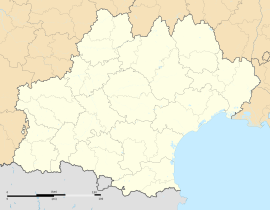Luz-Saint-Sauveur
You can help expand this article with text translated from the corresponding article in French. (July 2014) Click [show] for important translation instructions.
|
Luz-Saint-Sauveur | |
|---|---|
 The village of Luz-Saint-Sauveur | |
| Coordinates: 42°52′21″N 0°00′02″W / 42.8725°N 0.00056°W | |
| Country | France |
| Region | Occitania |
| Department | Hautes-Pyrénées |
| Arrondissement | Argelès-Gazost |
| Canton | La Vallée des Gaves |
| Government | |
| • Mayor (2001–2008) | Alain Lescoules |
| Area 1 | 50.38 km2 (19.45 sq mi) |
| Population (1999) | 1,098 |
| • Density | 22/km2 (56/sq mi) |
| Time zone | UTC+01:00 (CET) |
| • Summer (DST) | UTC+02:00 (CEST) |
| INSEE/Postal code | 65295 /65120 |
| Elevation | 677–3,194 m (2,221–10,479 ft) (avg. 711 m or 2,333 ft) |
| 1 French Land Register data, which excludes lakes, ponds, glaciers > 1 km2 (0.386 sq mi or 247 acres) and river estuaries. | |
Luz-Saint-Sauveur (Template:Lang-oc) is a commune in the Hautes-Pyrénées department in the Occitan region of south-western France. Locals simply call it Luz, the city took its current name from Luz-Saint-Sauveur on April 9, 1962. Its inhabitants are called the Luzeans. In the village, you can enjoy the exceptional historical heritage of the town by visiting the church of Saint-André but also known as "Les Templiers", but also the Pont Napoléon, the Château Sainte-Marie or the spa district. Protected by mountains to the east, west and south, and separated from the plain to the north by the Pierrefitte gorge, Luz-Saint-Sauveur feels like it is cut off from the outside world even though it is only a 1/2 hour drive from Lourdes.
Places and monuments
Templar church
Called "the Templars " actually Hospitallers of St John of Jerusalem , the church St. Andrew was built in xii th and xiii th centuries. In the xiv th century , the Hospitallers of Saint John of Jerusalem built walls around the church to protect the inhabitants of Luz attacks of Spanish bandits called " irregulars ". At that time, a large ditch surrounded the church and a drawbridgeallowed to cross it. A few years later, the chapel Notre-Dame-de-la-Pitié was built inside the ramparts to ask God to put an end to an epidemic of black plague which devastated the country Toy around 1650. In 1865, a new door has been opened to facilitate entry.




